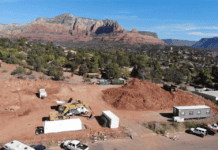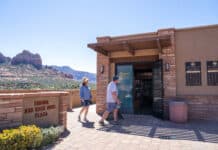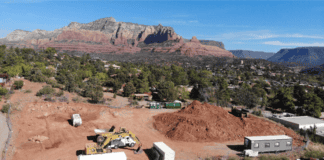Sedona may soon be entering the nuclear age.
The state of Arizona recently approached the city of Sedona and the property owners of the Sedona Cultural Park on the construction of small nuclear power plant at the site.
The station would not be anywhere near as large as the Palo Verde Nuclear Generating Station in Tonopah, which generates 3.3 gigawatts of power.
By net generation, Palo Verde is the largest nuclear power station in the country, serving roughly 4 million people in Arizona and Southern California, but the increasing population in the Southwest, means the power plant will reach capacity sooner rather than later, according to Palo Verde Nuclear Expansion Program Chief Spokeswoman Cher Nobel-Pripyat.
To combat global warming and be in compliance with the recently signed U.N Framework Convention on Climate Change, aka the Paris Agreement, U.S. officials are looking for ways to reduce carbon emissions. The Navajo Generating Station, a coal-fired power plant near Page, is the third largest emitter of carbon dioxide in the country, and will likely be phased out in favor of cleaner, less carbon-dependent power stations, Nobel-Pripyat said, which offered Palo Verde an opportunity to expand small “satellite” stations.
“There are currently 442 nuclear power plants in operation worldwide and 66 more under construction,” Nobel-Pripyat said. “Excluding three unfortunate incidents over the last 37 years, nuclear power plants are statistically safer than coal, oil and gas-fired power stations.”
The Sedona Red Rock Verde Valley Nuclear Generating Station would consist of one European Pressurized Reactor steam electric system designed by French company Areva. Four plants using this same technology are in operation or under construction in China, Finland and France.
The rated core thermal power will be just over 4,500 thermal megawatts and produce 1,600 megawatts of power. While this is less than the 2,250 megawatts produced by the Navajo station, other plants may be planned along the Interstate 17 corridor.
The plant would take three to four years to construct, and cost roughly $8 billion. It would pump reclamated water from Sedona’s Wastewater Reclamation Plant for the cooling process, then pump the water into Oak Creek via pipe south of Red Rock State Park. Once the plant was fully operational, the city of Sedona would receive a portion of proceeds for the use of local water, up to a maximum of $3 million per year, but more likely in the $2.2 million to $2.6 million range.
The Sedona Cultural Park has been vacant since 2004. The property has been in escrow for years — the seating area is overgrown with desert brush and the stage itself is in such a state of disrepair most of it would have to been torn down if a new owner wanted to reopen a performance venue.
In January, the property was sold to a private firm, Burns Holdings LLC, which has owned and operated a small nuclear power plant in Springfield, Ore., since December 1989. The plant would be jointly owned by Arizona Public Service, Burns Holdings, Salt River Project and Southern California Edison. Areva would own a minor portion for the first 10 years, before divvying up its share proportionally among the other stakeholders.
“We feel the Sedona site is excellent for our plans,” Burns Holdings CEO and owner C. Montgomery Burns said. “Excellent.”
Construction would likely not begin until summer 2017, after the conclusion of a National Environmental Policy Act assessment, which is set to be conducted this summer.
U.S. Forest Service Southwestern Regional Deputy Forester Jon Osterman said the NEPA study would likely not find any reason to hinder construction plans.
Burns added the firm recently made a $20 million donation to the U.S. Forest Service for upgrades to ranger stations and equipment, in a gesture of goodwill.
According to Sedona Red Rock Verde Valley Nuclear Generating Station Building Development Manager Akira D. Fukushima, the plant will likely be built where the Cultural Park’s stage and seating are currently and only about 25 percent of the cooling towers and building would be visible by nearby homeowners.
“We want to be a good corporate partner to the city and cause as little disruption to residents and visitors, while still providing excellent service up to International Atomic Energy Agency safety standards,” Fukushima said.
In keeping with the city’s aesthetic, Avena Public Relations Officer Lionel Mandrake said the cooling tower would likely be painted to match the red rocks surrounding the city of Sedona or a Southwestern-inspired turquoise, perhaps with sacred geometric symbols, pending approval by the Sedona Planning and Zoning Commission. The city would also be welcome to use the 11-story tower as a backdrop for the annual Fourth of July Laser Show.
Residents who want to offer comment in support of or opposition to the new Sedona Red Rock Verde Valley Nuclear Generating Station can email HappyAprilFoolsDay@sedonaaz.gov.
EDITOR’S NOTE:
We hope all our readers enjoyed our April Fools Day joke. Typically, we will ask a question about April Fools Day or write an editorial that lists possible April Fools Day headlines generated by our staff of based on their coverage of news stories. This year, after a suggestion by Sedona Arts Center Executive Director Eric Holowacz that we write a fictional piece, we decided a full story would be more fun for our readers.
We wanted to go with a story that would be so implausible that it bordered on absurd, then fill it in with enough details to make it seem like it might actually be real. While Managing Editor Christopher Fox Graham wrote the story, other suggestions to make the story even more ostentatious came from Larson Newspapers General Manager Kyle Larson, Copy Editors Michael Rinker and Andrew Pardiac, Photojournalist Jordan Reece and Assistant Managing Editor Ron Eland.
The technical information is based the proposed Bell Bend Nuclear Power Plant in Luzerne County, Pennsylvania, near the Susquehanna Steam Electric Station, which would actually use a European Pressurized Reactor system.
The email address “HappyAprilFoolsDay@sedonaaz.gov” is the giveaway that this was an April Fools Day joke, but there are earlier context clues throughout:
- The article’s author in the print edition is April Mendax, which in Latin translates to “Lying April.” Mendax is the Latin root of the English word “mendacious,” which means “deceitful” or “dishonest.”
- Palo Verde Nuclear Expansion Program Chief Spokeswoman Cher Noble-Pripyat is play on words of Chernobyl and the river Pripyat, which cooled the Chernobyl reactor, and the former Soviet city of Pripyat, where the plant’s employees lived.
Pripyat was evacuated after the Chernobyl disaster on April 26, 1986, and remains an abandoned city. The Chernobyl Nuclear Power Plant Zone of Alienation is a 30-kilometer area around the plant is off limits to anyone without a special permit for research or filmmaking, due to deadly amounts of radiation. - Cher Noble-Pripyat’s quote “Excluding three unfortunate incidents over the last 37 years, nuclear power plants are statistically safer than coal, oil and gas-fired power stations.” references the Level 5 Three Mile Island Nuclear Generating Station nuclear meltdown on March 28, 1979, near Harrisburg, Pennsylvania; the Level 7 Chernobyl disaster on April 26, 1986, near Pripyat, Ukraine; and the Level 7 Fukushima Daiichi nuclear disaster on March 11, 2011, near Ōkuma, Fukushima, Japan, caused by the Tōhoku earthquake and tsunami.
While the statement is accurate in terms of sheer counting, the financial cost of a nuclear accident dwarfs the cost of an accident at other power station, mainly due to the damage and cleanup costs of radioactive fallout. Cleanup of Three Mile Island started in August 1979, and officially ended in December 1993, with a total cleanup cost of about $1 billion. Cleanup of Chernobyl and Fukushima are still ongoing and will cost billions, not counting the high cost of medical treatment to those affected by the radiation who develop cancer.  Burns Holdings LLC CEO and owner C. Montgomery Burns is the same Mr. Burns who owns the Springfield Nuclear Power Plant in “The Simpsons” animated TV show. He’s “owned” that plant since December 1989, when “The Simpsons” debuted on the Fox network. His quote “Excellent” is his catchphrase.
Burns Holdings LLC CEO and owner C. Montgomery Burns is the same Mr. Burns who owns the Springfield Nuclear Power Plant in “The Simpsons” animated TV show. He’s “owned” that plant since December 1989, when “The Simpsons” debuted on the Fox network. His quote “Excellent” is his catchphrase.
- Normally our jump words (the word at the end of a front page story that connects to a story on the jump page so readers know which story is which) use a word from the headline. The jump word for this story is “April 1.”
- U.S. Forest Service Southwestern Regional Deputy Forester Jon Osterman is named the scientist who gets irradiated in an Intrinsic Field Subtractor and reforms his body, becoming the superpowered Dr. Manhattan in the 1986 “Watchmen” comic book writer Alan Moore, artist Dave Gibbons, and colorist John Higgins. In the 2009 movie “Watchmen,” he was portrayed by actor Billy Crudup. He glows blue due to Cherenkov radiation.
While there are about a dozen “superheroes” in the Watchman mythos, only Dr. Manhattan has actual superpowers. One of the subplots of the comic is that people who work alongside him develop cancer from their lengthy proximity to him. On discovering his former lover Janey Slater also has terminal cancer, he flees Earth for Mars.

- The sentence “Burns added the firm recently made a $20 million donation to the U.S. Forest Service for upgrades to ranger stations and equipment, in a gesture of goodwill.” is meant to imply Burns Holdings LLC bribed the U.S. Forest Service for a positive National Environmental Policy Act assessment that would allow for construction of the plant. In “The Simpsons,” Mr. Burns is a notoriously evil figure who bribes officials because of the Springfield Nuclear Power Plant’s abysmal safety record, mainly due to the fact that Homer Simpson is the plant’s Nuclear Safety Inspector.
- Sedona Red Rock Verde Valley Nuclear Generating Station Building Development Manager Akira D. Fukushima references both the 1988 anime film “Akira,” about a dystopian Neo-Tokyo, and the Fukushima Daiichi nuclear power plant.
In “Akira” the destruction of the first Tokyo was believed to have been a nuclear attack, setting off World War III, but the acutal cause was a psychic explosion of the titular character Akira.
The Fukushima Daiichi Nuclear Power Plant suffered a meltdown after the March 11, 2011 Tōhoku earthquake and tsunami. Although not stated, the “D” in Akira D. Fukushima’s name stands for Daiichi.
For these two reasons, Akira D. Fukushima is ironically the one who makes the statement that plant would be up to “International Atomic Energy Agency safety standards.” - Avena Public Relations Officer Lionel Mandrake is named for Royal Air Force Group Capt. Lionel Mandrake one of three characters portrayed by Peter Sellers in the 1964 black comedy “Dr. Strangelove or: How I Learned to Stop Worrying and Love the Bomb,” the other two being U.S. President Merkin Muffley and Dr. Strangelove, a wheelchair-bound ex-Nazi scientist who serves as President Muffley’s science advisor. Mandrake fails to stop B-52 Stratofortress bomber’s commander Major T. J. “King” Kong from dropping a bomb on the Soviet Union, triggering a doomsday device that initiates Mutual Assured Destruction and effectively destroys the world at the end of the film.
- Painting the cooling tower to match the red rocks surrounding the city of Sedona or a Southwestern-inspired turquoise, perhaps with sacred geometric symbols is a humorous allusion to other such design proposals brought before the Sedona Planning and Zoning Commission and the Sedona City Council.
- The people we shot and quoted for People on the Street on Page 4A were in on the joke, which is why their quotes are uniformly in favor of the nuclear power plant.
The staff sincerely thanks Larson Newspapers General Manager Kyle Larson for allowing us to have a bit of fun with our readers on April Fools Day.


















